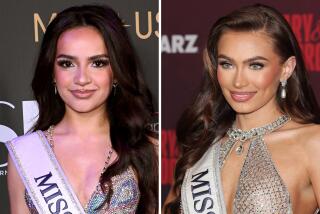A lift for the only thing sagging -- its ratings
- Share via
EVERY year, it seems, there’s a new plan to reverse the long downhill slide of the Miss America pageant and return it to the must-watch status it enjoyed half a century ago, when 27 million viewers -- almost 40% of the television audience -- tuned in for three hours of bathing suits, ball gowns and baton twirling.
In recent years, the length of the broadcast has been cut by a third. The easily ridiculed talent competition was largely eliminated, confined to the three finalists. Bathing suits got more modest, then less modest and paired with bare feet. In 2001, the pageant producers came up with a “Survivor”-type idea, where eliminated contestants voted to decide who would remain on the beauty island.
And when that landed ABC the pageant’s smallest audience ever -- 9.8 million viewers -- the show moved to Country Music Television, which set the show in Las Vegas instead of Atlantic City, N.J., and pulled in an audience of just 3.1 million for the live show.
But when the pageant premiere ranked as the most-watched telecast in CMT’s history, the network set about building Miss America’s “event” status. The big idea for 2007: back story. Thus, “Pageant School: Becoming Miss America,” a two-hour reality show meant to bring the contestants to life as they master the intricacies of the competitive charm and beauty circuit.
“Pageant School” airs Friday at 9 p.m. and repeats frequently over the weekend -- running also on sister networks MTV and VH1 -- leading up to the Jan. 29 pageant, and the hope is that viewers will find contestants to identify with, champion and disdain -- then tune in to find out who wins the real competition.
There’s nakedly ambitious Miss Delaware, Jamie Ginn, 24, the oldest contestant and one of the few brunettes, who points out that she gave up a “huge” salary as a chemical engineer to compete; Miss South Dakota, Callee Bauman, who exhibits a wry, self-deprecating sense of humor; plus dozens more characters to reveal hopes, fear of wearing short-shorts and lust for the crown.
“Unlike a lot of reality shows, we were dealing with a huge cast,” said Paul Villadolid, CMT’s vice president of programming and development, who helped create “Pageant School” and oversaw all production.
“We have 52 contestants. We wanted to come up with a way where each could have their moment in the sun. We also wanted to give them some real, constructive advice.”
An interactive website (www.missamerica.cmt.com) lets viewers learn more about the contestants -- Miss Kansas’ favorite book is Ecclesiastes; Miss Arizona’s favorite food is Skittles -- and participate in a $1-million choose-the-winner sweepstakes.
Pageant queen next door
WITH the new emphasis on showing the contestants as real people -- flaws, preferences, imperfect histories and all -- “I do think you lose a little of the mystique,” admitted Sam Haskell, chairman of the Miss America Organization. But that’s less important, he says, than giving viewers something to relate to. And a reality approach, he said, is not that much of a reach, for in the old days “you could take a Mississippi belle or a Kansas farm girl and make her a star overnight.”
If less mystery, more history means knowing Miss Massachusetts wears an internal cardiac defibrillator or Miss Arkansas enjoys duck hunting, so be it.
Filmed over five days at the Loews Santa Monica Beach Hotel last September, “Pageant School” is close kin to “America’s Next Top Model.” In lieu of Tyra Banks is earnest, husky-voiced pageant school coach Erika Schwartz Wright, the 1997 Miss America runner-up, who heads a panel of three experts: Phyllis George, Miss America 1971; Angela Baraquio Grey, Miss America 2001; and Dale Smith Thomas, another pageant coach. Current Miss America Jennifer Berry (nee Miss Oklahoma) is also on hand to offer advice and information.
The goal, we learn, is to level the playing field by giving contestants feedback on their strengths and weaknesses. Some have been competing in the pageant system since they were children, others for a matter of mere months.
During “school,” everyone gets makeup lessons (“no ‘80s makeup”), movement tips in the form of a line-dancing competition, a catwalk in sweats rather than evening wear (to make the point that it’s about the person, not the clothes) and participates in a “swimsuits through the decades” competition.
Through it all, pageant school coach Wright offers such bits of wisdom as: “The minute you doubt, you have let someone else beat you,” “Do your best, show your personality and have a good time” and “You cannot fake confidence.”
On the last day, participants have a chance to meet and question three of the people who will judge the actual pageant: actress and Miss Florida 1974 Delta Burke, singer Michael Feinstein and actress, dancer and choreographer Debbie Allen (who, unfortunately, never once utters: “Fame costs! Are you ready to pay the price?”).
Finally, the most improved contestant is crowned pageant school queen. The prize: a $23,000 diamond necklace.
If the pageant and its packaging have changed, the motivation for entering seems fairly consistent: Last year, the Miss America organization made available more than $45 million in cash and scholarship assistance at the local, state and national levels. The winner of Miss America takes home $30,000, but she’s often pocketed thousands more along the way.
“I see it as a training ground for the rest of my life,” said Heidi Voight, Miss Connecticut, during a break in the filming. “I was living in a studio apartment with a hamster and no light when I first started competing” at age 20.
And if the reality-show treatment reveals contestants to be all too human, that doesn’t bother Christina Hall, Miss New Mexico. “There’s this image of Miss America as this flawless, untouchable creature. It used to be reserved for the daughters of the wealthiest, most powerful families of every state. It’s not that way anymore.”
CMT’s Villadolid agrees. “In a lot of pageants these women are reduced to models,” he says. “I think that what ‘Pageant School’ has done is it has really humanized them. They’re shown as approachable, down-to-earth, smart women.”
More to Read
The complete guide to home viewing
Get Screen Gab for everything about the TV shows and streaming movies everyone’s talking about.
You may occasionally receive promotional content from the Los Angeles Times.






